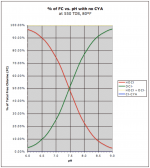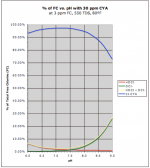Hello! This is my first post here ever! So.... My out-of-ground 15,000 gallon pool has been greenish and cloudy for two weeks. TWO /HOT/ WEEKS! I used a bunch of pool store  on the pool to no avail. So, I found this place (thankfully). Here's where I am right now:
on the pool to no avail. So, I found this place (thankfully). Here's where I am right now:
I flocked the pool (before reading your advice) and I've vacuumed a ton of Crud to waste.
Yesterday, I brushed down the entire floor and walls (which were definitely algae-coated)
Yesterday, I changed the sand in my filter (I went to just clean it, but the tube thingy got stuck to the top and pulled out, so I decided to start fresh).
I purchased the recommended Taylor Pool Kit (but not "C" because too costly) and tested yesterday. FC 0.8 ppm. CC 0.6 ppm.
I lowered Ph to desired range.
I can't figure out pool calculator, so I just added two gallons of super shock yesterday last night and tested this morning: FC 8.4 ppm; CC 1 ppm.
I added another gallon of super shock and waited two hours to test: FC 14.2 ppm. CC 0.6 ppm.
The water looks clear.
QUESTIONS:
How much more shock should I add now to get it to 16-20 range?
How many more gallons (about) of liquid chlorine should I have on hand?
Is it possible that the CC level went up overnight, or did I just mis-test this morning?
Is my CC really bad or just a little? I'm wondering how many days of this SLAM until I can swim (preferable before September)?!
Thank you!
I flocked the pool (before reading your advice) and I've vacuumed a ton of Crud to waste.
Yesterday, I brushed down the entire floor and walls (which were definitely algae-coated)
Yesterday, I changed the sand in my filter (I went to just clean it, but the tube thingy got stuck to the top and pulled out, so I decided to start fresh).
I purchased the recommended Taylor Pool Kit (but not "C" because too costly) and tested yesterday. FC 0.8 ppm. CC 0.6 ppm.
I lowered Ph to desired range.
I can't figure out pool calculator, so I just added two gallons of super shock yesterday last night and tested this morning: FC 8.4 ppm; CC 1 ppm.
I added another gallon of super shock and waited two hours to test: FC 14.2 ppm. CC 0.6 ppm.
The water looks clear.
QUESTIONS:
How much more shock should I add now to get it to 16-20 range?
How many more gallons (about) of liquid chlorine should I have on hand?
Is it possible that the CC level went up overnight, or did I just mis-test this morning?
Is my CC really bad or just a little? I'm wondering how many days of this SLAM until I can swim (preferable before September)?!
Thank you!




